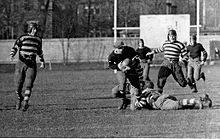Burnside rules

TheBurnside ruleswere a set of rules that transformedCanadian footballfrom arugby-style game to thegridiron-style game it has remained ever since. The rules were first adopted by theOntario Rugby Football Unionin1903,and were named after John Thrift Meldrum Burnside, captain of theUniversity of Torontofootball team (although he did not originate them). The Burnside rules introduced sweeping changes to the way football was played.[1]
The rules included:
- a reduction from 15 to 12 players per side
- a reduction from 8 to 6 men allowed on the line of scrimmage when the ball was put into play
- the "snap-back "system in which the ball was passed backward from a staticline of scrimmageby thecentre
- a requirement for a team to make tenyardsin three successivedownsor lose possession of the ball
Although similar, Burnside rules had many differences and evolved separately from theAmerican footballrules already in place at the time. The American code had been developed byWalter Campin the 1880s (later on, it made some modifications to its rules).[2]Although these rules are standard today, at the time they were considered radical. Other teams outside the Ontario Rugby Football Union refused to adopt them until1921.[citation needed]For the1906season they did adopt the Inter-Collegiate rules of 10 yards to gain in 3 downs.
TheAlberta Union's playing rules were drawn up by the Reverend Robert 'Bob' Pearson, duringWorld War I;the Alberta Union rules were heavily influenced by the Burnside rules, which Pearson had known as a player.[3]In late1920,these rules were agreed to by the other Western Canadian football unions.[3]TheCanadian Rugby UnionRules Committee had been seeking to standardize its rules under its former presidentW. A. Hewitt,and proposed a very similar version of the new Alberta Union rules in April 1921. The CRU's proposed regulations were approved to be used in1921 in Canadian football.[3]
References
[edit]- ^"100th Grey Cup - Toronto - Grey Cup History Timeline 1900".Archived fromthe originalon 2012-09-22.Retrieved2015-01-18.History of the Grey Cup
- ^Camp, Walter (1893-01-01).American Football.Harper & brothers.
- ^abcCosentino, Frank (1969).Canadian Football: The Grey Cup Years.pp. 49, 50.ISBN1365981827.
